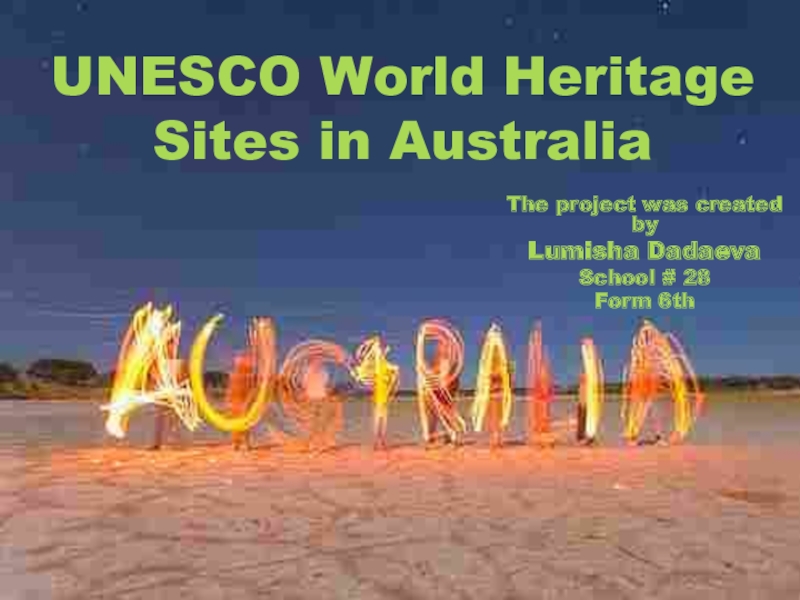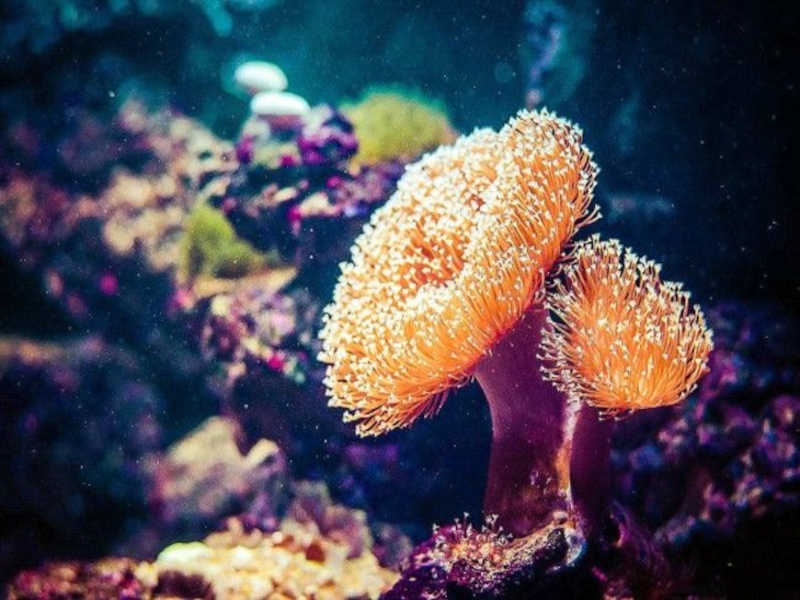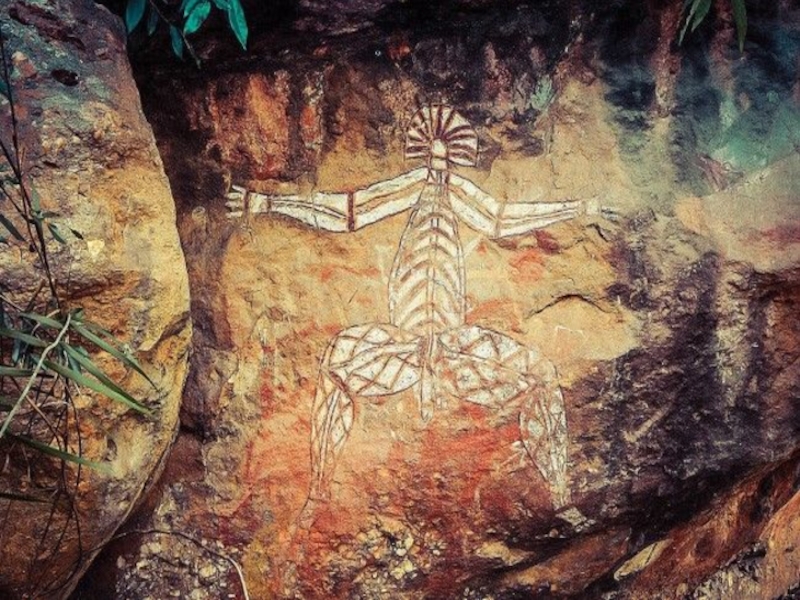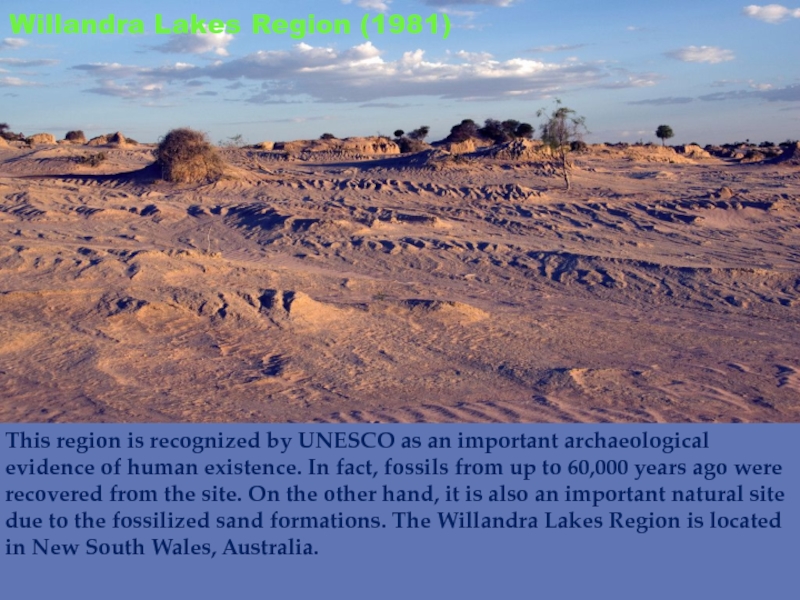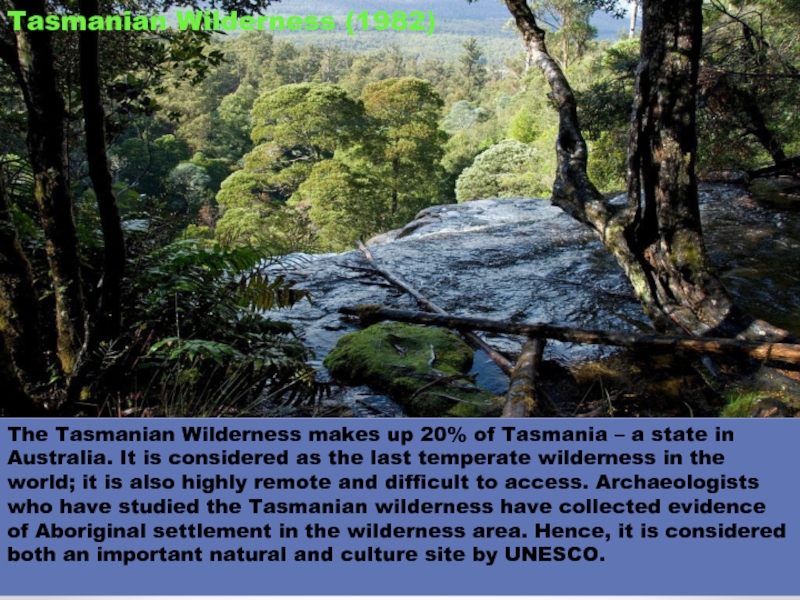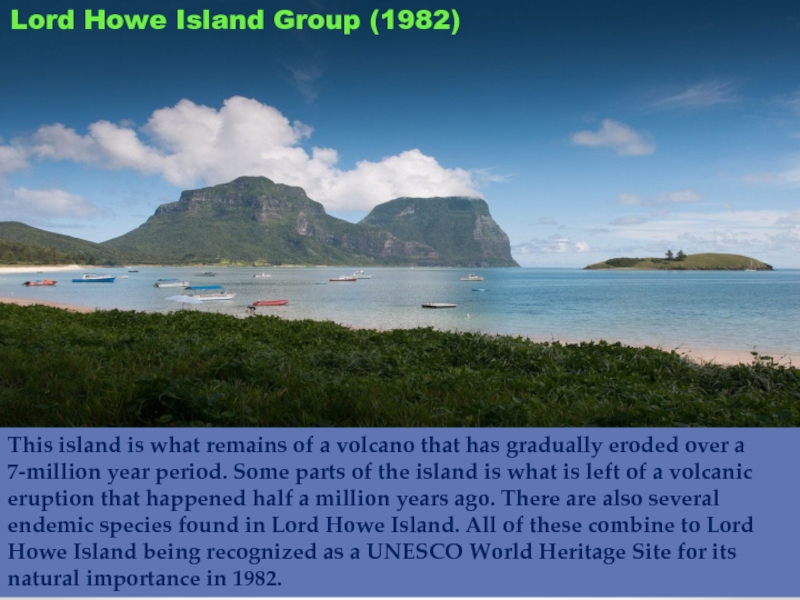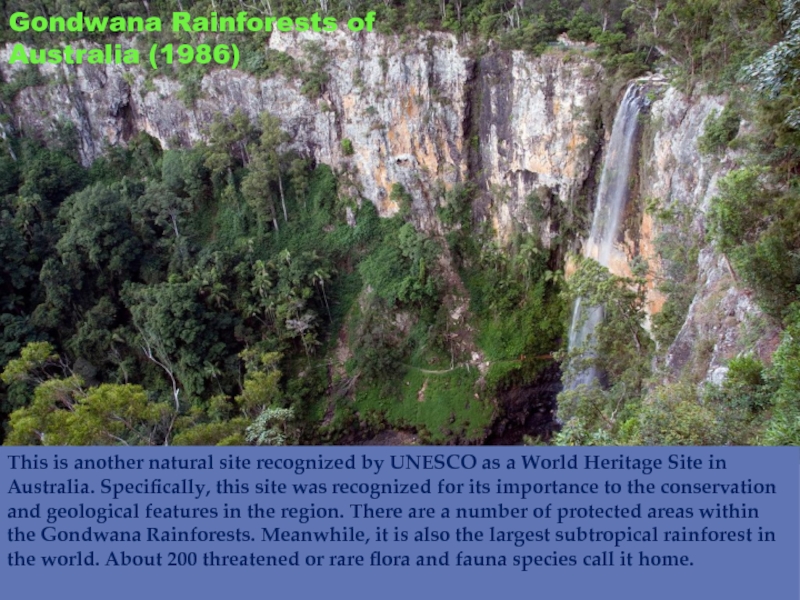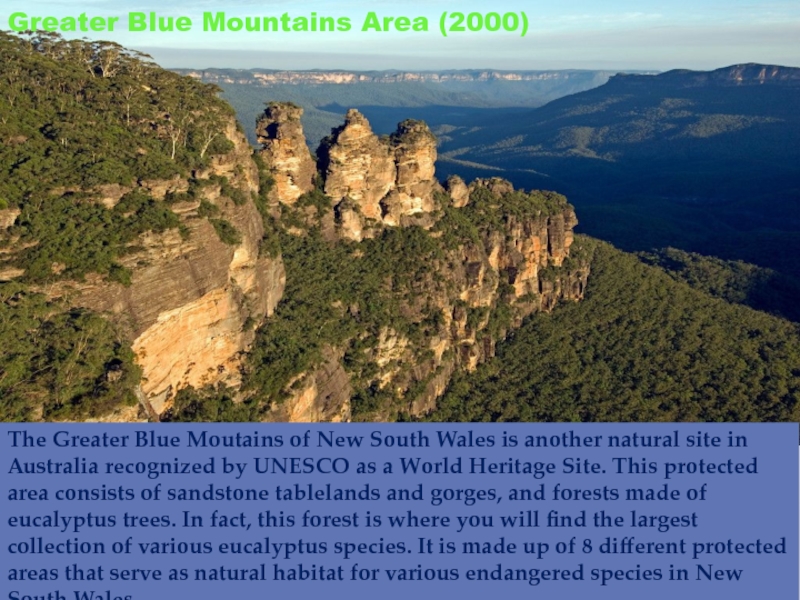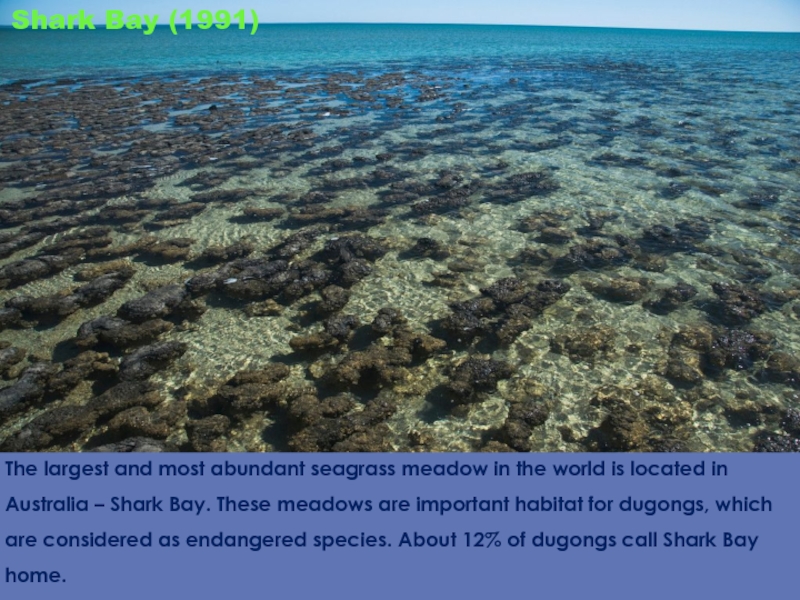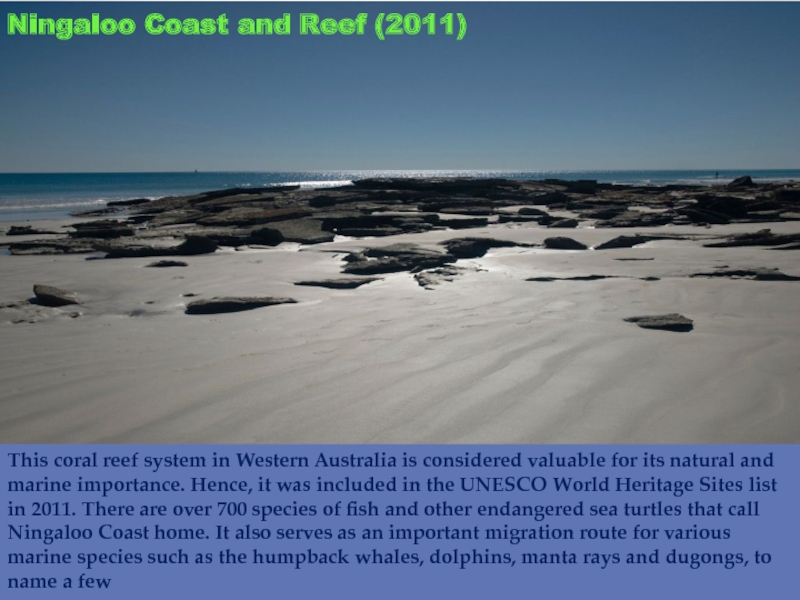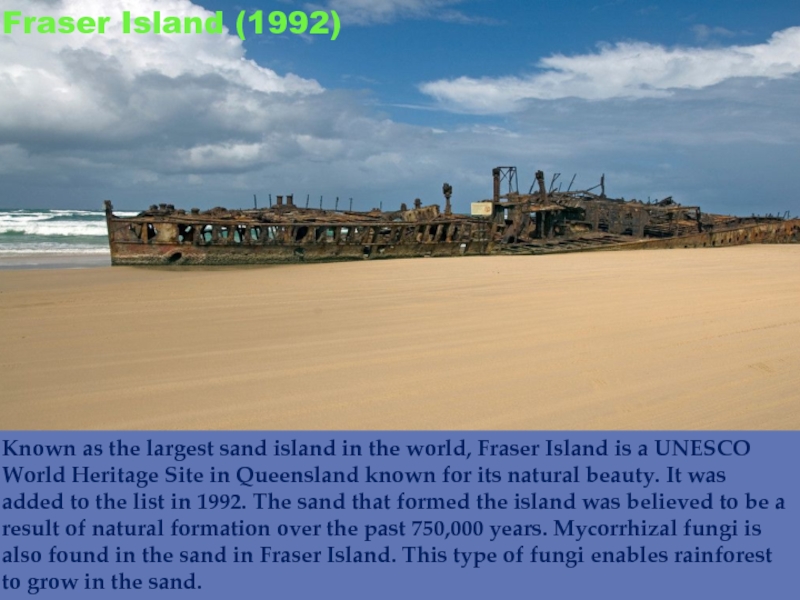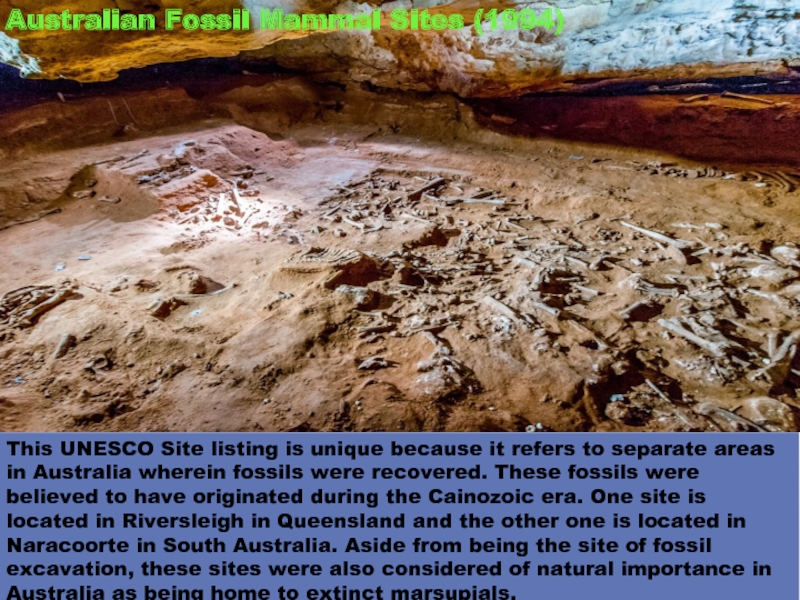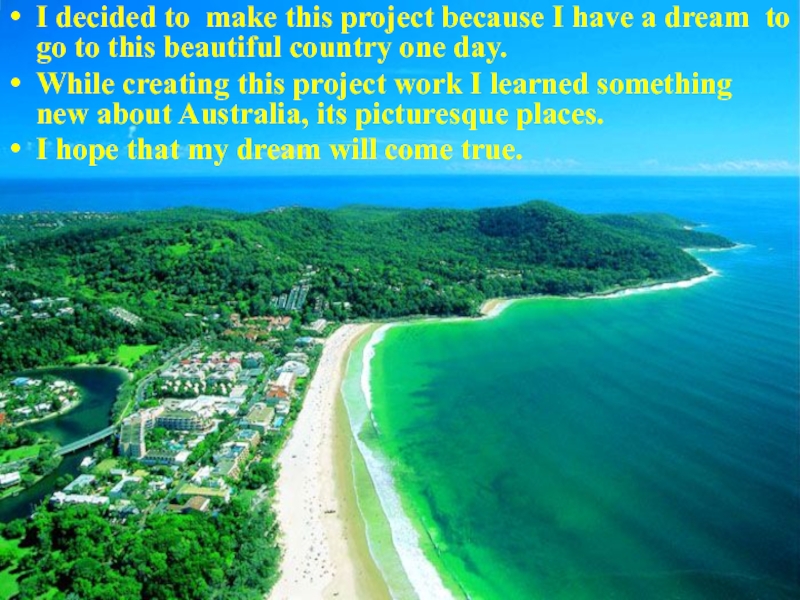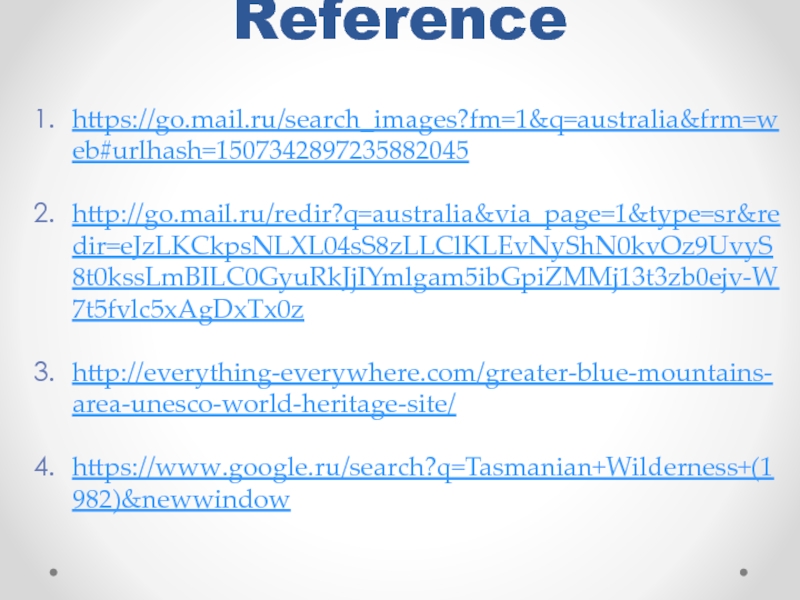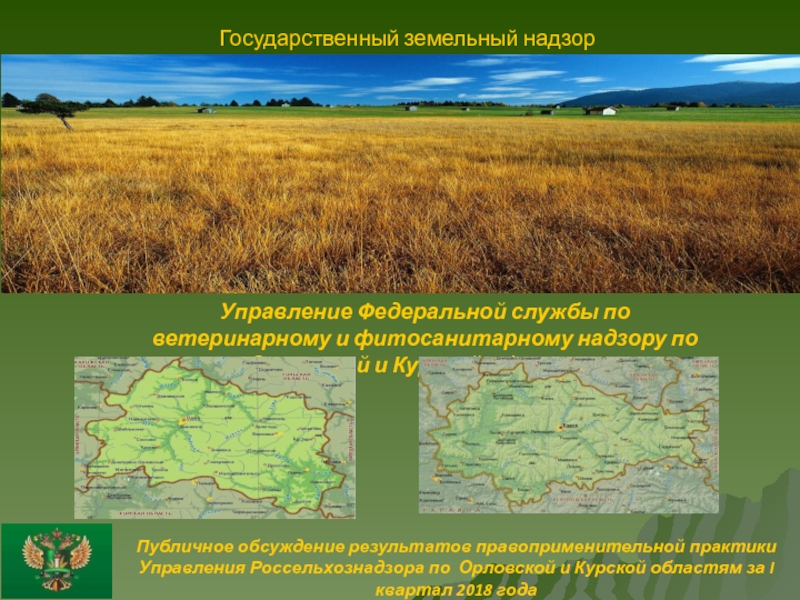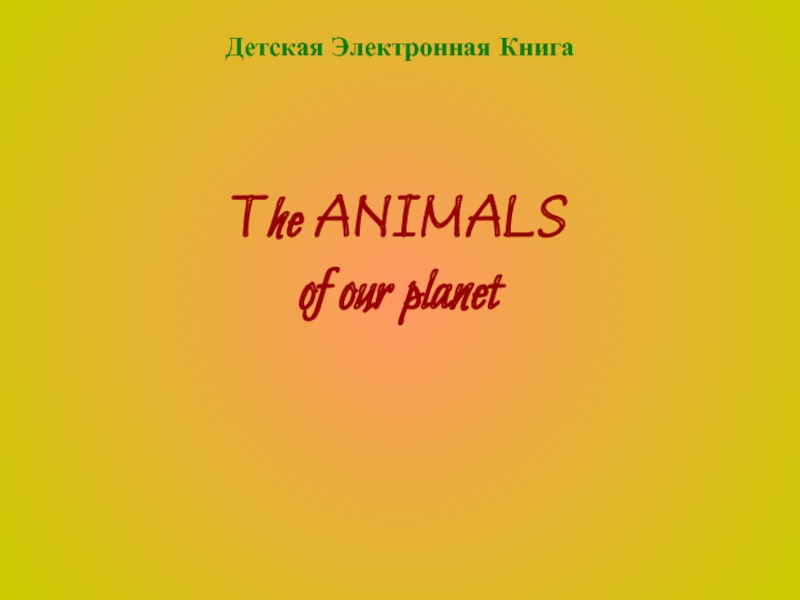Разделы презентаций
- Разное
- Английский язык
- Астрономия
- Алгебра
- Биология
- География
- Геометрия
- Детские презентации
- Информатика
- История
- Литература
- Математика
- Медицина
- Менеджмент
- Музыка
- МХК
- Немецкий язык
- ОБЖ
- Обществознание
- Окружающий мир
- Педагогика
- Русский язык
- Технология
- Физика
- Философия
- Химия
- Шаблоны, картинки для презентаций
- Экология
- Экономика
- Юриспруденция
UNESCO World Heritage Sites in Australia
Содержание
- 1. UNESCO World Heritage Sites in Australia
- 2. Great Barrier Reef (1981)The largest coral reef
- 3. Слайд 3
- 4. Kakadu National Park (1981)The Kakadu National Park
- 5. Слайд 5
- 6. Willandra Lakes Region (1981)This region is recognized
- 7. Tasmanian Wilderness (1982)The Tasmanian Wilderness makes up
- 8. Слайд 8
- 9. Lord Howe Island Group (1982)This island is
- 10. Gondwana Rainforests of Australia (1986)This is another
- 11. Greater Blue Mountains Area (2000)The Greater Blue
- 12. Purnlulu National Park (2003)The Purnlulu National Park
- 13. Shark Bay (1991)The largest and most abundant
- 14. Wet Tropics of Queensland (1988)The tropical rainforest
- 15. Ningaloo Coast and Reef (2011)This coral reef
- 16. Fraser Island (1992)Known as the largest sand
- 17. Australian Fossil Mammal Sites (1994)This UNESCO Site
- 18. I decided to make this project because
- 19. Reference https://go.mail.ru/search_images?fm=1&q=australia&frm=web#urlhash=1507342897235882045http://go.mail.ru/redir?q=australia&via_page=1&type=sr&redir=eJzLKCkpsNLXL04sS8zLLClKLEvNyShN0kvOz9UvyS8t0kssLmBILC0GyuRkJjIYmlgam5ibGpiZMMj13t3zb0ejv-W7t5fvlc5xAgDxTx0zhttp://everything-everywhere.com/greater-blue-mountains-area-unesco-world-heritage-site/https://www.google.ru/search?q=Tasmanian+Wilderness+(1982)&newwindow
- 20. Thanks for watching
- 21. Скачать презентанцию
Great Barrier Reef (1981)The largest coral reef in the world is in Australia and it is also a UNESCO World Heritage Site under the Natural category. Located in Queensland, the Great
Слайды и текст этой презентации
Слайд 2Great Barrier Reef (1981)
The largest coral reef in the world
is in Australia and it is also a UNESCO World
Heritage Site under the Natural category. Located in Queensland, the Great Barrier Reef is home to over 3,000 coral reefs and 600 islands. It is the largest structure in the world made of purely living things. In fact, the Great Barrier Reef is visible from the outer space.Слайд 4Kakadu National Park (1981)
The Kakadu National Park is a mixed
site; it was inscripted into the UNESCO World Heritage Site
in 1981. The Kakadu wetlands is the most prominent feature of the park, which also makes up for a third of the park’s entire area. Archaeological research into the area shows evidence of settlement in the area for over 40,000 years. Meanwhile, pictographs have also been uncovered in the site, which is similar to the Aboriginal rock art from the ancient times.Слайд 6Willandra Lakes Region (1981)
This region is recognized by UNESCO as
an important archaeological evidence of human existence. In fact, fossils
from up to 60,000 years ago were recovered from the site. On the other hand, it is also an important natural site due to the fossilized sand formations. The Willandra Lakes Region is located in New South Wales, Australia.Слайд 7Tasmanian Wilderness (1982)
The Tasmanian Wilderness makes up 20% of Tasmania
– a state in Australia. It is considered as the
last temperate wilderness in the world; it is also highly remote and difficult to access. Archaeologists who have studied the Tasmanian wilderness have collected evidence of Aboriginal settlement in the wilderness area. Hence, it is considered both an important natural and culture site by UNESCO.Слайд 9Lord Howe Island Group (1982)
This island is what remains of
a volcano that has gradually eroded over a 7-million year
period. Some parts of the island is what is left of a volcanic eruption that happened half a million years ago. There are also several endemic species found in Lord Howe Island. All of these combine to Lord Howe Island being recognized as a UNESCO World Heritage Site for its natural importance in 1982.Слайд 10Gondwana Rainforests of Australia (1986)
This is another natural site recognized
by UNESCO as a World Heritage Site in Australia. Specifically,
this site was recognized for its importance to the conservation and geological features in the region. There are a number of protected areas within the Gondwana Rainforests. Meanwhile, it is also the largest subtropical rainforest in the world. About 200 threatened or rare flora and fauna species call it home.Слайд 11Greater Blue Mountains Area (2000)
The Greater Blue Moutains of New
South Wales is another natural site in Australia recognized by
UNESCO as a World Heritage Site. This protected area consists of sandstone tablelands and gorges, and forests made of eucalyptus trees. In fact, this forest is where you will find the largest collection of various eucalyptus species. It is made up of 8 different protected areas that serve as natural habitat for various endangered species in New South Wales.Слайд 12Purnlulu National Park (2003)
The Purnlulu National Park in Western Australia
is a natural site recognized by UNESCO into the World
Heritage Sites list in 2003. The most prominent feature at this national park is the Bungle Bungle Range, which is a plateau that eroded to form into a unique conical sandstone towers. Another major attraction in Purnlulu National Park is the large sandstone karst formation that is the largest in the world. This natural was added to the UNESCO list in 2003.Слайд 13Shark Bay (1991)
The largest and most abundant seagrass meadow in
the world is located in Australia – Shark Bay. These
meadows are important habitat for dugongs, which are considered as endangered species. About 12% of dugongs call Shark Bay home.Слайд 14Wet Tropics of Queensland (1988)
The tropical rainforest at the Great
Dividing Range of Queensland in Australia is a UNESCO World
Heritage Site due to its natural value. There is a high level of biodiversity in the rainforest – at least 85 species can be found only in the rainforest of Queensland. The endangered marsupials can also be found here.Слайд 15Ningaloo Coast and Reef (2011)
This coral reef system in Western
Australia is considered valuable for its natural and marine importance.
Hence, it was included in the UNESCO World Heritage Sites list in 2011. There are over 700 species of fish and other endangered sea turtles that call Ningaloo Coast home. It also serves as an important migration route for various marine species such as the humpback whales, dolphins, manta rays and dugongs, to name a fewСлайд 16Fraser Island (1992)
Known as the largest sand island in the
world, Fraser Island is a UNESCO World Heritage Site in
Queensland known for its natural beauty. It was added to the list in 1992. The sand that formed the island was believed to be a result of natural formation over the past 750,000 years. Mycorrhizal fungi is also found in the sand in Fraser Island. This type of fungi enables rainforest to grow in the sand.Слайд 17Australian Fossil Mammal Sites (1994)
This UNESCO Site listing is unique
because it refers to separate areas in Australia wherein fossils
were recovered. These fossils were believed to have originated during the Cainozoic era. One site is located in Riversleigh in Queensland and the other one is located in Naracoorte in South Australia. Aside from being the site of fossil excavation, these sites were also considered of natural importance in Australia as being home to extinct marsupials.Слайд 18I decided to make this project because I have a
dream to go to this beautiful country one day.
While creating
this project work I learned something new about Australia, its picturesque places.I hope that my dream will come true.
